
Oreocryptophis porphyraceus – CANTOR, 1839
(Elaphe porphyracea)
(Elaphe porphyracea)
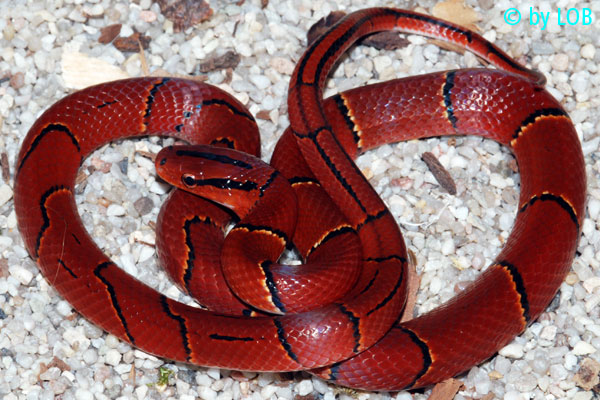
Oreocryptophis porphyraceus laticinctus: Semiadult captive-bred specimen • Halbwüchsiges Nachzuchttier
© Lutz Obelgönner
© Lutz Obelgönner
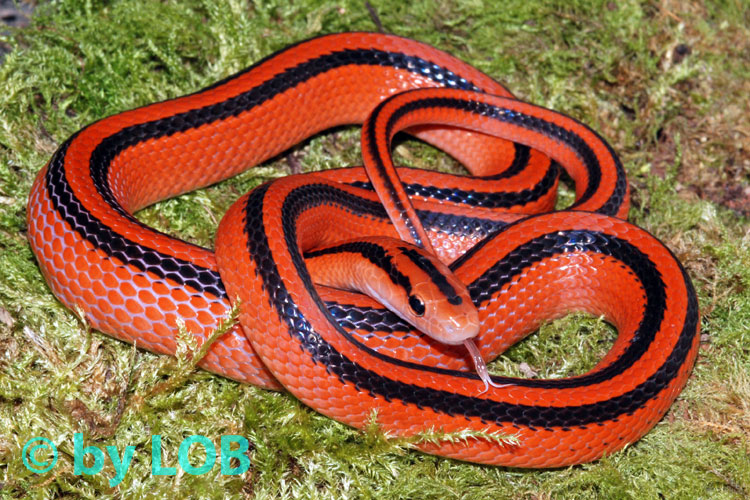
Oreocryptophis porphyraceus coxy: Captive-bred juvenile, just about a year old • Nachzuchttier, knapp ein Jahr alt
© Lutz Obelgönner
© Lutz Obelgönner
Red Bamboo Snake / Black-banded Trinket Snake
Description
Non-venomous. Was formerly a species of the genus Elaphe. The new, monotypic genus name reflects its secretive life in mountainous regions and comes from Greek oros='mountain', kryptos='hidden, secretive' und ophis='snake'. The species name comes from Latin porphyraceus='purple'. They are primarily a burrowing species but will enjoy climbing if given the opportunity. The Thai Red Mountain Ratsnake (Oreocryptophis porphyraceus coxi) is the only one of the Bamboo Ratsnakes which retains its pattern and colouration into adulthood although the bright colour will dull off a little as they age.
Because of its colourful appearance and small size this species is a sought-after pet. There are larger numbers of captive-bred animals of the most colourful subspecies available by now replacing those wild-caughts that came as death candidates and have led to much frustration among herpers for many years. This species lives very secretive and reacts aggressive and snappy to disturbances even though adults tend to calm down a bit. Crepuscular and nocturnal.
Protection
none
Adult Size
90 cm
Lifespan
more than 15 years
Distribution
There are six accepted subspecies at the moment:
Oreocryptophis porphraceus coxi (NE Thailand)
Oreocryptophis porphraceus kawakamii (Taiwan)
Oreocryptophis porphraceus laticinctus (Malaysia), Oreocryptophis porphraceus porphyraceus (eastern foothills of Himalaya, from Nepal to NW Thailand)
Oreocryptophis porphraceus pulchrus (south-eastern China, foothills of Himalaya)
Oreocryptophis porphraceus vaillanti (China, Hainan, Laos, Vietnam, Thailand)
Habitat
ground-dwelling in regions of tropical mountain forest, predominantly in 1,000–2,600 metres above sea level, with low, but dense vegetation, in moss, piles of wood, or piles of plants
Captive Care
Cage 80x50x50 cm WDH, rack system is a good alternative. Species needs a humid hiding box, e. g. plastic box with sphagnum moss, but no aggregated humidity. Keep rest of the cage and the substrate (e.g. coconut fibre) only slightly humid. Day temperature about 22–26 °C, night temperature 18–20 °C, allergic to higher temperatures, humidity 50–70 %. Daylight fluorescent lamps or LED (lighting not necessary), small drinking bowl, plants possible.
Food
rodents in appropriate size, good feeders, feed modestly
Reproduction and Rearing
Pairs possible, needs a cooler period (12 °C for 2–3 months) for reproduction. Some subspecies (O. p. coxi) can produce up to 3 clutches with 3–8 eggs, others only one clutch. Incubate at 26–27 °C for 50–55 days. Hatchlings normally accept pinkies, raise individually.
Non-venomous. Was formerly a species of the genus Elaphe. The new, monotypic genus name reflects its secretive life in mountainous regions and comes from Greek oros='mountain', kryptos='hidden, secretive' und ophis='snake'. The species name comes from Latin porphyraceus='purple'. They are primarily a burrowing species but will enjoy climbing if given the opportunity. The Thai Red Mountain Ratsnake (Oreocryptophis porphyraceus coxi) is the only one of the Bamboo Ratsnakes which retains its pattern and colouration into adulthood although the bright colour will dull off a little as they age.
Because of its colourful appearance and small size this species is a sought-after pet. There are larger numbers of captive-bred animals of the most colourful subspecies available by now replacing those wild-caughts that came as death candidates and have led to much frustration among herpers for many years. This species lives very secretive and reacts aggressive and snappy to disturbances even though adults tend to calm down a bit. Crepuscular and nocturnal.
Protection
none
Adult Size
90 cm
Lifespan
more than 15 years
Distribution
There are six accepted subspecies at the moment:
Oreocryptophis porphraceus coxi (NE Thailand)
Oreocryptophis porphraceus kawakamii (Taiwan)
Oreocryptophis porphraceus laticinctus (Malaysia), Oreocryptophis porphraceus porphyraceus (eastern foothills of Himalaya, from Nepal to NW Thailand)
Oreocryptophis porphraceus pulchrus (south-eastern China, foothills of Himalaya)
Oreocryptophis porphraceus vaillanti (China, Hainan, Laos, Vietnam, Thailand)
Habitat
ground-dwelling in regions of tropical mountain forest, predominantly in 1,000–2,600 metres above sea level, with low, but dense vegetation, in moss, piles of wood, or piles of plants
Captive Care
Cage 80x50x50 cm WDH, rack system is a good alternative. Species needs a humid hiding box, e. g. plastic box with sphagnum moss, but no aggregated humidity. Keep rest of the cage and the substrate (e.g. coconut fibre) only slightly humid. Day temperature about 22–26 °C, night temperature 18–20 °C, allergic to higher temperatures, humidity 50–70 %. Daylight fluorescent lamps or LED (lighting not necessary), small drinking bowl, plants possible.
Food
rodents in appropriate size, good feeders, feed modestly
Reproduction and Rearing
Pairs possible, needs a cooler period (12 °C for 2–3 months) for reproduction. Some subspecies (O. p. coxi) can produce up to 3 clutches with 3–8 eggs, others only one clutch. Incubate at 26–27 °C for 50–55 days. Hatchlings normally accept pinkies, raise individually.
Rote Bambusnatter / Breitband-Bambusnatter
Generelles
Ungiftig. Gehörte früher zur Gattung Elaphe. Die neue, monotypische Gattungsbezeichnung spiegelt die versteckte Lebensweise in Bergregionen wider und kommt vom griechischen oros="Berg", kryptos="versteckt" und ophis="Schlange". Der Artname kommt vom lateinischen porphyraceus="violett". Hauptsächlich im Untergrund unterwegs, aber bei entsprechender Einrichtung klettern die Tiere auch. Die thailändische Form Oreocryptophis porphyraceus coxi ist die einzige, die ihr prächtiges Jugendkleid auch im Erwachsenenalter behält. Wegen ihrer Farbigkeit und geringen Größe ein begehrter Pflegling, wobei von den schönsten Unterarten inzwischen auch regelmäßig gut haltbare Nachzuchten erhältlich sind, während Wildfänge lange Zeit als fast sichere Todeskandidaten galten. Die Art lebt sehr versteckt und reagiert bei Störungen hektisch bis bissig, adulte Tiere werden ruhiger. Dämmerungs- und nachtaktiv.
Schutzstatus
keiner
Größe
90 cm
Lebenserwartung
über 15 Jahre
Vorkommen
Zurzeit sechs anerkannte Unterarten:
Oreocryptophis porphraceus coxi (Nordost-Thailand)
Oreocryptophis porphraceus kawakamii (Taiwan)
Oreocryptophis porphraceus laticinctus (Malaysia)
Oreocryptophis porphraceus porphyraceus (östliche Himalaya-Ausläufer, Nepal bis Nordwest-Thailand)
Oreocryptophis porphraceus pulchrus (südöstliches China, Himalaya-Ausläufer)
Oreocryptophis porphraceus vaillanti (China, Hainan, Laos, Vietnam, Thailand)
Habitat
bodenbewohnend in tropischen Bergwaldregionen, überwiegend in 1000–2600 Meter Höhe, mit niedriger, dichter Vegetation, in Moos, Holzstapeln oder Pflanzenhaufen
Haltung
Terrarium 80x50x50 cm BTH, auch gut für Racksystem geeignet. Die Art braucht ein leicht feuchtes Versteck, etwa eine Plastikdose mit Sphagnummoos, aber keine Staunässe. Deshalb sollte auch das restliche Bodensubstrat (z.B. Kokoshumus) nur leicht feucht sein. Lufttemperatur tagsüber etwa 22–26 °C, nachts 18–20 °C, reagiert empfindlich auf höhere Temperaturen. Luftfeuchtigkeit 50–70 %. Sonstiges: Tageslichtleuchtstoffröhren oder LEDs möglich, aber nicht notwendig, Trinkgefäß, natürliche Pflanzen sind möglich.
Futter
Mäuse, Rattenbabies, gute Fresser, zurückhaltend füttern
Zucht und Aufzucht
Paarhaltung möglich, Winterruhe 2–3 Monate bei etwa 12 °C als Paarungsauslöser. Einige Unterarten (O. p. coxi) können bis 3 Gelege mit je 3–8 Eiern pro Jahr produzieren, andere legen nur ein Gelege. Schlupf nach 50–55 Tagen Inkubation bei 26–27 °C. Jungtiere akzeptieren im Normalfall Babymäuse, Einzelaufzucht sinnvoll.
Ungiftig. Gehörte früher zur Gattung Elaphe. Die neue, monotypische Gattungsbezeichnung spiegelt die versteckte Lebensweise in Bergregionen wider und kommt vom griechischen oros="Berg", kryptos="versteckt" und ophis="Schlange". Der Artname kommt vom lateinischen porphyraceus="violett". Hauptsächlich im Untergrund unterwegs, aber bei entsprechender Einrichtung klettern die Tiere auch. Die thailändische Form Oreocryptophis porphyraceus coxi ist die einzige, die ihr prächtiges Jugendkleid auch im Erwachsenenalter behält. Wegen ihrer Farbigkeit und geringen Größe ein begehrter Pflegling, wobei von den schönsten Unterarten inzwischen auch regelmäßig gut haltbare Nachzuchten erhältlich sind, während Wildfänge lange Zeit als fast sichere Todeskandidaten galten. Die Art lebt sehr versteckt und reagiert bei Störungen hektisch bis bissig, adulte Tiere werden ruhiger. Dämmerungs- und nachtaktiv.
Schutzstatus
keiner
Größe
90 cm
Lebenserwartung
über 15 Jahre
Vorkommen
Zurzeit sechs anerkannte Unterarten:
Oreocryptophis porphraceus coxi (Nordost-Thailand)
Oreocryptophis porphraceus kawakamii (Taiwan)
Oreocryptophis porphraceus laticinctus (Malaysia)
Oreocryptophis porphraceus porphyraceus (östliche Himalaya-Ausläufer, Nepal bis Nordwest-Thailand)
Oreocryptophis porphraceus pulchrus (südöstliches China, Himalaya-Ausläufer)
Oreocryptophis porphraceus vaillanti (China, Hainan, Laos, Vietnam, Thailand)
Habitat
bodenbewohnend in tropischen Bergwaldregionen, überwiegend in 1000–2600 Meter Höhe, mit niedriger, dichter Vegetation, in Moos, Holzstapeln oder Pflanzenhaufen
Haltung
Terrarium 80x50x50 cm BTH, auch gut für Racksystem geeignet. Die Art braucht ein leicht feuchtes Versteck, etwa eine Plastikdose mit Sphagnummoos, aber keine Staunässe. Deshalb sollte auch das restliche Bodensubstrat (z.B. Kokoshumus) nur leicht feucht sein. Lufttemperatur tagsüber etwa 22–26 °C, nachts 18–20 °C, reagiert empfindlich auf höhere Temperaturen. Luftfeuchtigkeit 50–70 %. Sonstiges: Tageslichtleuchtstoffröhren oder LEDs möglich, aber nicht notwendig, Trinkgefäß, natürliche Pflanzen sind möglich.
Futter
Mäuse, Rattenbabies, gute Fresser, zurückhaltend füttern
Zucht und Aufzucht
Paarhaltung möglich, Winterruhe 2–3 Monate bei etwa 12 °C als Paarungsauslöser. Einige Unterarten (O. p. coxi) können bis 3 Gelege mit je 3–8 Eiern pro Jahr produzieren, andere legen nur ein Gelege. Schlupf nach 50–55 Tagen Inkubation bei 26–27 °C. Jungtiere akzeptieren im Normalfall Babymäuse, Einzelaufzucht sinnvoll.
Literature / Literatur
Bulian, Joachim, Siebert, B. & Ansermet, M. (2005). Zur Nachzucht der Roten Breitband-Bambusnatter, Oreocryptophis porphyraceus laticinctus SCHULZ & HELFENBERGER 1998. Reptilia 10 (6): 67–70. NTV, Münster.
Bulian, Joachim, Siebert, B . & Ansermet, M. (2006). Captive Breeding of the Broad-Banded Red Bamboo Ratsnake Oreocryptophis porphyraceus laticinctus. Reptilia (English edition) (46): 47–49. Barcelona.
Grossmann, Wolfgang & Schulz, Klaus-Dieter (2000). Elaphe porphyracea laticincta SCHULZ & HELFENBERGER. Sauria 22 (2):2. TGB, Berlin.
Grossmann, Wolfgang & Tillack, Frank (2004). Angaben zur Haltung und Vermehrung der Breitband-Porphyrnatter Oreocrytophis porphyraceus laticincta (SCHULZ & HELFENBERGER 1998) (Squamata: Colubridae). Sauria, 26 (1): 37–44. TGB, Berlin.
Knietsch, Verena (2005). Die Terrarienhaltung der Thailändischen Roten Bambusnatter (Oreocrytophis porphyraceus coxi) sowie eine seltene Zwillingsgeburt. Reptilia 10 (6): 62–66. NTV, Münster.
Schulz, Klaus-Dieter (1996). A monograph of the colubrid snakes of the genus Elaphe FITZINGER. Koeltz Scientific Books, Königstein im Taunus.
Schulz, Klaus-Dieter (1996). Eine Monographie der Schlangengattung Elaphe FITZINGER. Bushmaster, Berg/CH.
Schulz, Klaus Dieter & Helfenberger, Notker (1998). Eine Revision des Unterarten-Komplexes der Roten Bambusnatter Elaphe porphyracea (CANTOR, 1839). Sauria 20 (1): 25–45.
Bulian, Joachim, Siebert, B. & Ansermet, M. (2005). Zur Nachzucht der Roten Breitband-Bambusnatter, Oreocryptophis porphyraceus laticinctus SCHULZ & HELFENBERGER 1998. Reptilia 10 (6): 67–70. NTV, Münster.
Bulian, Joachim, Siebert, B . & Ansermet, M. (2006). Captive Breeding of the Broad-Banded Red Bamboo Ratsnake Oreocryptophis porphyraceus laticinctus. Reptilia (English edition) (46): 47–49. Barcelona.
Grossmann, Wolfgang & Schulz, Klaus-Dieter (2000). Elaphe porphyracea laticincta SCHULZ & HELFENBERGER. Sauria 22 (2):2. TGB, Berlin.
Grossmann, Wolfgang & Tillack, Frank (2004). Angaben zur Haltung und Vermehrung der Breitband-Porphyrnatter Oreocrytophis porphyraceus laticincta (SCHULZ & HELFENBERGER 1998) (Squamata: Colubridae). Sauria, 26 (1): 37–44. TGB, Berlin.
Knietsch, Verena (2005). Die Terrarienhaltung der Thailändischen Roten Bambusnatter (Oreocrytophis porphyraceus coxi) sowie eine seltene Zwillingsgeburt. Reptilia 10 (6): 62–66. NTV, Münster.
Schulz, Klaus-Dieter (1996). A monograph of the colubrid snakes of the genus Elaphe FITZINGER. Koeltz Scientific Books, Königstein im Taunus.
Schulz, Klaus-Dieter (1996). Eine Monographie der Schlangengattung Elaphe FITZINGER. Bushmaster, Berg/CH.
Schulz, Klaus Dieter & Helfenberger, Notker (1998). Eine Revision des Unterarten-Komplexes der Roten Bambusnatter Elaphe porphyracea (CANTOR, 1839). Sauria 20 (1): 25–45.
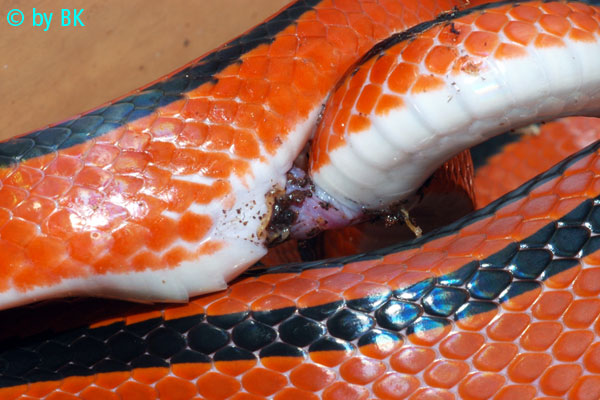
Oreocryptophis porphyraceus coxy: Copulation • Paarung
© Boris Klusmeyer
© Boris Klusmeyer
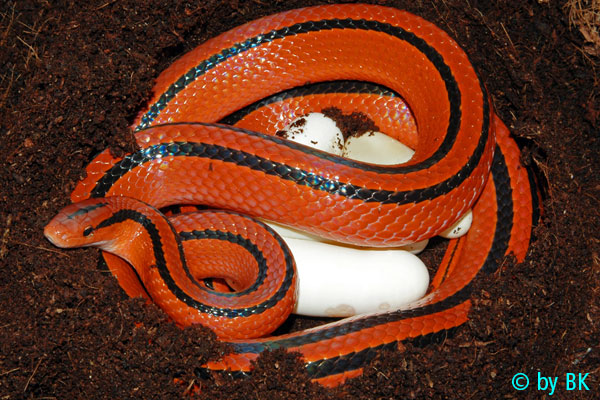
Oreocryptophis porphyraceus coxy: Captive-bred female after egg deposition • Nachzuchtweibchen nach der Eiablage
© Boris Klusmeyer
© Boris Klusmeyer

Oreocryptophis porphyraceus coxy: Hatchling • Schlupf
© Boris Klusmeyer
© Boris Klusmeyer
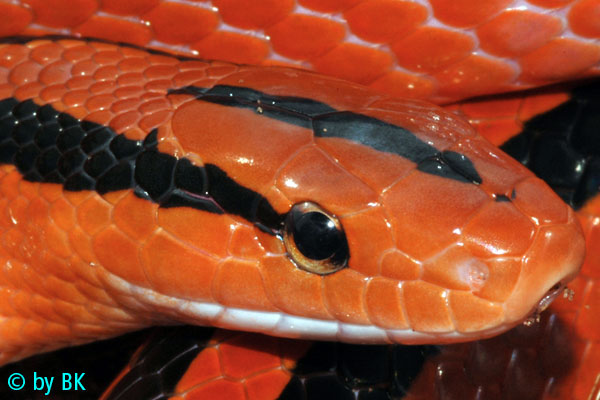
Oreocryptophis porphyraceus coxy: Portrait of adult captive-bred male • Porträt eines Nachzuchtmännchens
© Boris Klusmeyer
© Boris Klusmeyer
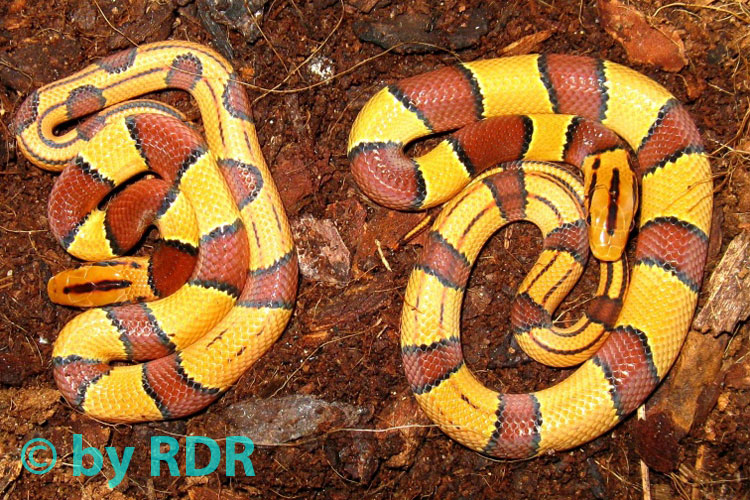
Oreocryptophis porphyraceus laticinctus: Juveniles show striking colouration • Jungtiere zeigen leuchtende Farben.
© Radek Drimal
© Radek Drimal
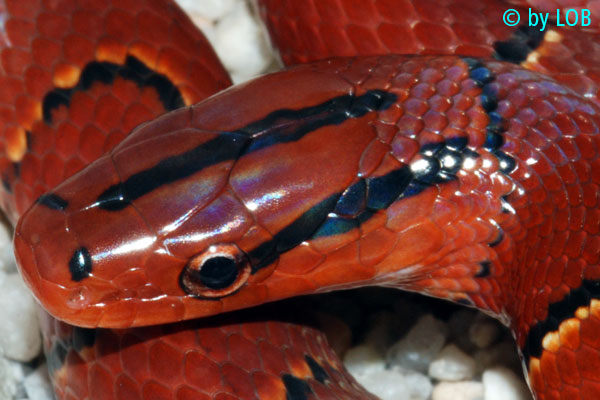
Oreocryptophis porphyraceus laticinctus: Later they lose all yellow parts and turn red • Später verlieren sich die gelben Elemente und das namensgebende Rot dominiert.
© Lutz Obelgönner
© Lutz Obelgönner
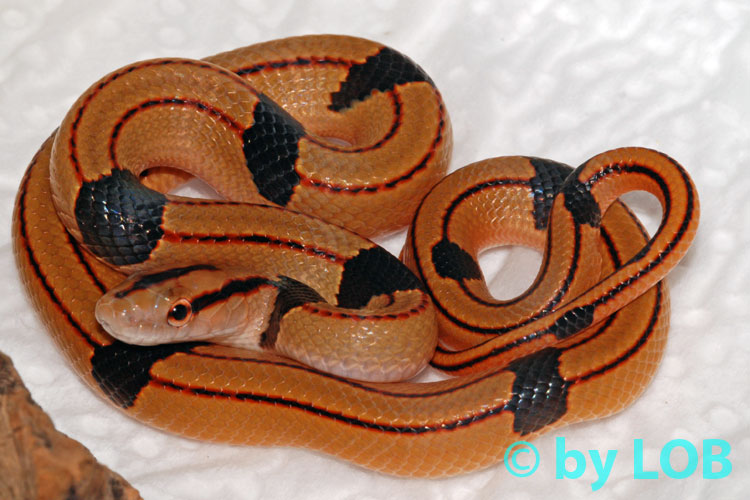
Oreocryptophis porphyraceus vaillanti: One of the less spectacular subspecies of the red bamboo snake • Eine der eher farblosen Unterarten der Roten Bambusnatter
© Lutz Obelgönner
© Lutz Obelgönner
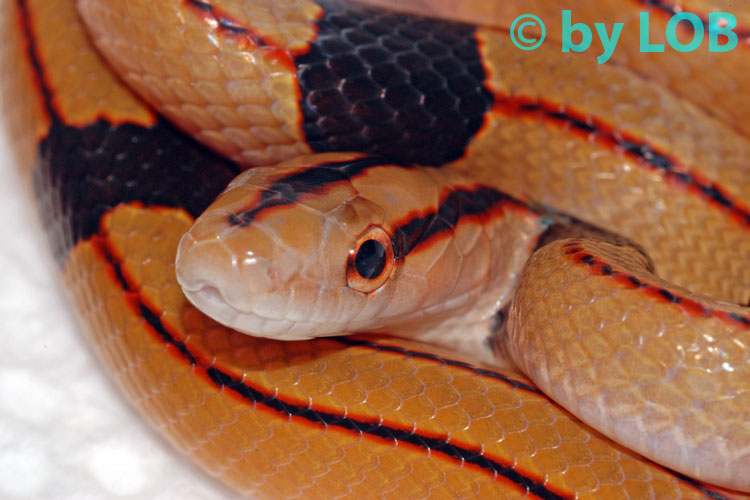
Oreocryptophis porphyraceus vaillanti: Portrait of juvenile • Porträt eines Jungtieres
© Lutz Obelgönner
© Lutz Obelgönner